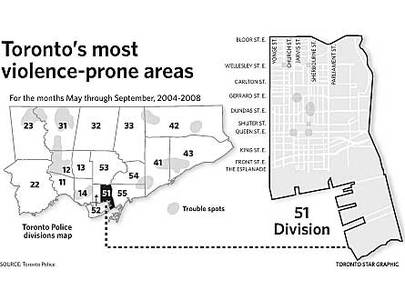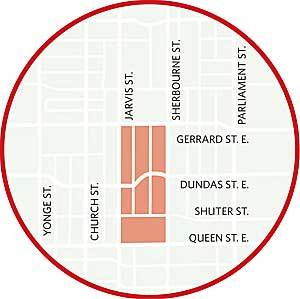Dundas-Sherbourne ranks No. 1 in violence
Dundas-Sherbourne corridor ranks No. 1 in city for violent offences, data shows
Sep 01, 2009 04:30 AM
Robyn Doolittle
Crime Reporter
A body is sprawled across the middle of the road, but no one stops.
And why would they? This is George St., home to Seaton House – the city’s largest homeless shelter, a booming drug trade and a scuzzy strip club-hotel, all in the most violent quarter of the city.
More than North York’s Jane St. and Finch Ave. intersection or the west end’s Keele St. and Eglinton Ave. neighbourhood, the downtown Dundas and Sherbourne Sts. corridor ranks first in virtually every category of violent crime, based on sheer volume and crime per square kilometre, according to documents obtained by the Star.
In street robberies, assault-related offences and what police call “violent calls for service” (which encompasses shootings, stabbings, a person with a knife or gun, and sex attacks) the six downtown blocks south of Allan Gardens top every list.

TORONTO STAR GRAPHIC

The area south of Allan Gardens is the city’s most crime-plagued.
By volume, Dundas and Sherbourne ranks fourth behind Jane and Finch, Keele and Eglinton, and Albion Rd. and Finch Ave. But on a per-square-kilometre basis, the area is No. 1.
“That’s what happens when you put all the city’s poorest people together on the same block,” said Garry De Jong, a 48-year-old janitor who pays $440 a month to live in a rooming house on Dundas St. E., just east of Jarvis St.
The downtown east side, south of Gerrard St. E. and north of Queen St. E., and between Jarvis and Sherbourne Sts., houses three of the city’s largest shelters. On any given day, as many as 1,000 homeless people will descend on the region, napping on the sidewalks and fighting in the streets.
Million-dollar townhouses guarded by two-metre iron fences line these streets. Many have surveillance cameras over the front door. Prostitutes work the east side of Allan Gardens. Addicts twitching from withdrawal walk in circles in front of Moss Park. And crack dealers flock to George St. to ply their trade.
It’s busiest on Thursdays, says 30-year-old Julie Harland, because that’s the day the transients get their “personal needs allowance.”
Harland began renting a townhouse on the north end of George St. in 2000 when she was attending Ryerson University. Four years later, the unit next to hers went on the market for $180,000.
“What can I say, it’s about 1,800 square feet. Five floors with two bedrooms. (My husband and I) got a great deal,” she said, walking her perfectly groomed Yorkshire terrier, Izzie, near the Allan Gardens dog park. For the most part, she says, they don’t have any problems with the locals, although she has had to spray a few with the garden hose to get them off her property.
Last summer, 51 Division’s Dundas and Sherbourne was selected – along with Jane and Finch in North York – to receive additional support from the Toronto Anti-Violence Intervention Strategy during the peak crime months of May to September. During those months between 2004-2008, there were 257 street robberies in the Dundas and Sherbourne neighbourhood – compared to 196 at second-place Jane and Finch. Over the same period, there were 3,947 assault-related calls in the downtown region, as opposed to 2,579 in the Dundas and Dovercourt area.
This year, based on the crime data report, TAVIS was deployed to Jane and Finch and 12 Division’s Keele and Eglinton after a rash of shooting homicides in the spring.
Staff Supt. Glenn De Caire, who decided not to return TAVIS officers to 51 Division this summer, says there are considerable city resources in that area. (A city official cited the Streets to Homes program, counselling, housing and health support provided at Seaton House and the massive revitalization of nearby Regent Park.)
“The TAVIS-focused neighbourhood deployment had great success last summer,” he said. Compared to this time last year, there has been a 6.5 per cent drop in overall crime. “And TAVIS, the divisional strategy, is still being used in 51 (Division) this year – we haven’t just forgotten about the neighbourhood.”
But the region requires a community approach to policing, he said.
“We can go out there and fill up the cells every night, but that’s the wrong thing to do. There is the education. There is prevention. We need to get some of the people who are homeless into shelters. Some of the people who suffer from emotional disturbances, we need to get them to a place of help,” he said. “These are people who don’t belong in jail, they need to be somewhere where they can get the help they need.”
The report was compiled in February by the Crime Information Analysis Unit. The TAVIS officers deployed in 31 and 12 Division this summer were scheduled to leave on Sept. 20, but that’s been extended.
http://thestar.com/news/gta/article/689148
1 Comment
Leave a Comment
要发表评论,您必须先登录。





Dundas-Sherbourne暴力罪案率多伦多第1
提起多伦多最不安全地区,多伦多市民可能马上想起北约克的Jane-Finch 地区,或者西区的Keele-Eglinton 社区,但根据多伦多警方提供的资料,市中心Dundas-Sherbourne地区几乎在每个犯罪类型的统计方面,尤其是每平方公里面积发生的案件数上,无可争议地居于全市第1的地位。
警方的资料表明,论犯罪案件总数,Dundas-Sherbourne地区排在Jane-Finch、Keele-Eglinton、Albion-Finch 之后居第4位,但在按每平方公里计算的案件数量上,Dundas-Sherbourne地区排第1位。这些罪案包括街头抢劫、枪击、刺伤以及性犯罪等等。该区不仅集中了多伦多最穷的人、最多的无家可归者、也有最多的吸毒贩毒者。而具有讽刺意味的是,在这个地区的北面一点,即Bloor St以北却是著名的富人区——Rosedale地区。